Spring land-clearing ideas
SIOUX FALLS, S.D., March 30, 2023 – Spring has sprung! With days getting longer and temperatures on the rise, it’s time for land-clearing...
The spotted lanternfly is an invasive species making its way across the country. This article will help you understand more about this pest, how you can help your customers and how to make a profit.
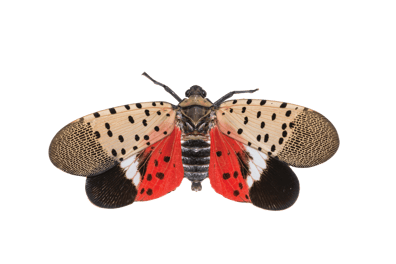
History in the U.S.
The spotted lanternfly (Lycorma delicatula) was first discovered in the U.S. in 2014 in eastern Pennsylvania. It’s believed that egg masses were transported into the U.S. via a shipment of stone in Philadelphia (more likely slate for landscaping than gravel).
Since being identified in 2014, aggressive efforts from the Pennsylvania Department of Agriculture to slow the spread of the spotted lanternfly (SLF) were enacted. Quarantine measures have been in place for impacted (and neighboring) counties for years, and a public relations campaign was launched to raise awareness among Pennsylvania residents.
Native Range, Life Cycle and Behaviors
The spotted lanternfly is native to China, India and Vietnam. It also spread to Korea and Japan years before it arrived in the US, so reports that it arrived from China directly are unverifiable.
Contrary to the name, the lanternfly isn’t a true “fly.” It’s in the scientific order “Hemiptera,” along with cicadas, hoppers, aphids and “true bugs.” SLF is classified as a plant-hopper.
It feeds on plants using needlelike mouth parts, piercing the bark of a plant and sucking out the sap. It processes that sap inefficiently and secretes a watery substance filled with the sugars from the tree. This secretion is called “honeydew.” (This is not unique to the spotted lanternfly; aphids and other pests with piercing/sucking mouthparts also secrete honeydew.)
When feeding in high enough numbers, the sugars in the honeydew will begin to ferment. You’ll walk onto a property with a high SLF population, and it smells like rotting fruit.
The life cycle is comprised of four instars before adulthood. The first three are nearly identical in appearance; they’re black bodies with white, polka-dot-like spots. The only noticeable difference is the size.
The fourth instar is much larger and has a black body with prominent red markings and maintains those white spots. Adults have gray-spotted wings and red underwings. They have black and yellow bodies (similar to a bee but without the fuzz) and large red eyes.
The first instar can emerge as early as 240 Growing Degree Days (GDD) or as late as 1,174. Adults emerge between 1,696 and 3,232 GDD. Shortly after emergence, they’ll begin to mate and lay eggs. Eggs are laid with a waxy covering that makes treating them with an insecticide difficult. This means first emergence is usually in spring and adult emergence in the summer for most markets.
SLF will continue to lay eggs all the way up until you get consistently freezing overnight temperatures, which kill off the adult population. Egg masses are laid on almost anything; trees, natural stones found in the landscape and firewood are obvious. But SLF will also lay eggs on manmade objects; tires, the wheel wells of vehicles, the sides of RVs and railcars have all seen SLF egg masses.
Its preferred host plant is the Ailanthus altissima, commonly known as the “Tree of Heaven” or sometimes “Chinese sumac.” It was assumed for a long time that SLF needed the Tree of Heaven to complete its reproductive cycle. However, it’s proven to be incredibly adaptable.
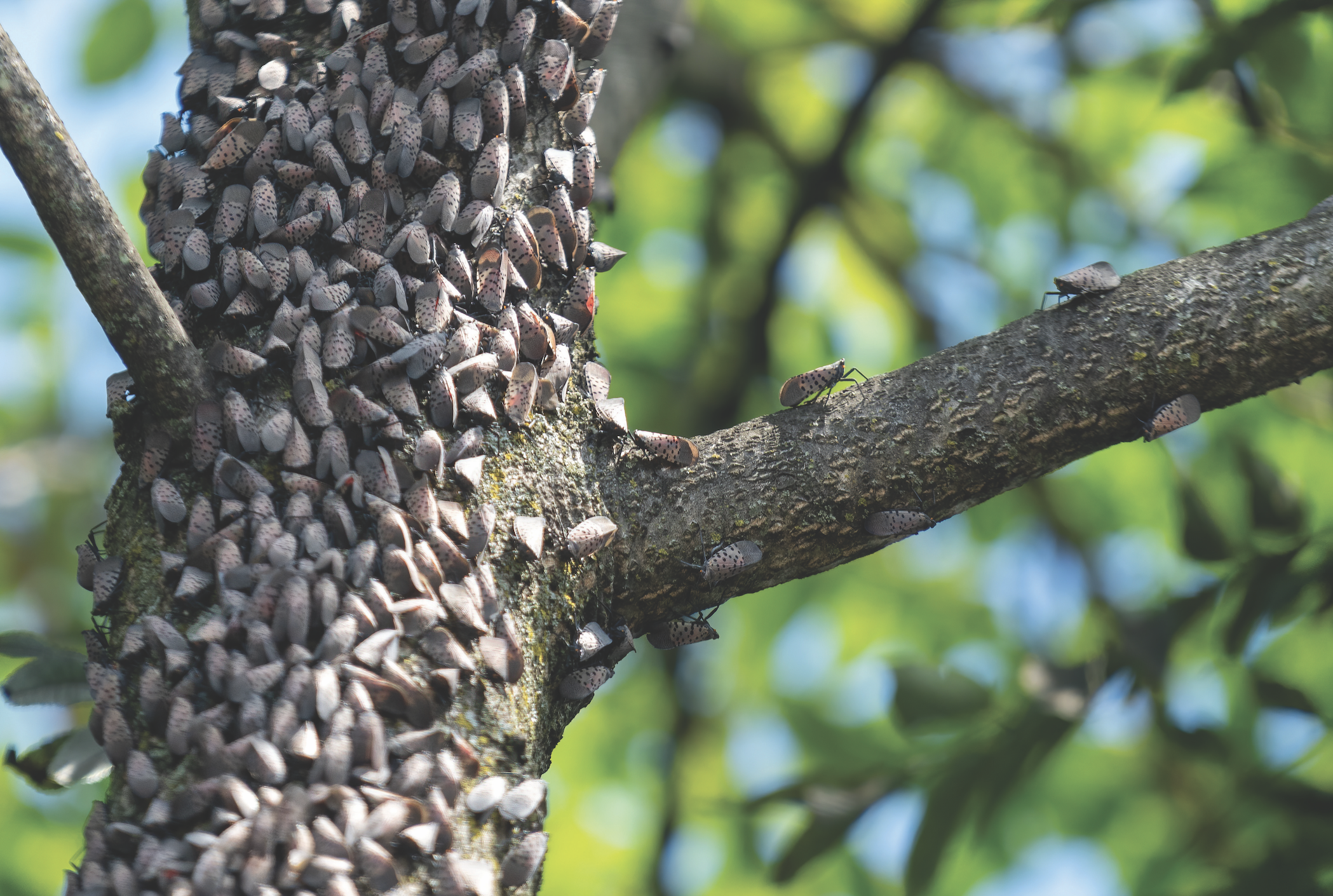
In the U.S., it’s begun to feed on and reproduce using other trees. Anything with relatively high sugar content in the sap is at risk; fruit trees (ornamental and agricultural), grapes and hops are targets. In the landscape, maples (especially sugar and red maples) are vulnerable. I’ve observed feeding on birch, and I’ve had coworkers observe feeding on tulip poplars.
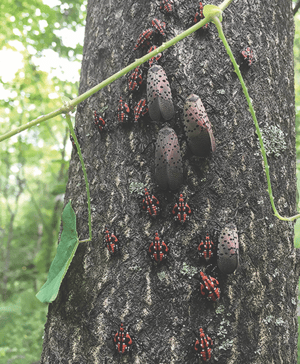
Controlling Spotted Lanternfly
Responsible control for SLF involves cultural practices and, when necessary, chemical control.
Cultural Practices
Several cultural practices help slow the spread of spotted lanternflies.
First, you should scrape egg masses. When you see an egg mass, take a firm object (like a credit card or paint scraper) and manually remove the egg masses. Place them in a Ziplock-style baggie with a small amount of rubbing alcohol or hand sanitizer. Do a thorough walkthrough of the property in question, manually remove the egg masses and dispose of the baggie in the trash. Do this in the winter.
Another practice is to employ “sticky bands.” Similar to glue traps as you’d use for rodents, but for trees. You place these bands around the trees you’re trying to protect, the sticky side facing away from the tree. As SLF nymphs try to climb up the tree to reach thinner bark, they’ll get caught, and you can simply put the band in a bag and throw it away.
Professional-grade bands can be purchased online but are NOT recommended at this time. They tend to catch birds and small mammals. You’ll be fine with a decent Duct tape wrapped around the tree with the sticky side facing away from the tree. It need only be two to three strips wide. It is recommended to coil some chicken wire and cover the sticky band with it; this will give vertebrates a way to step over the band without getting stuck, but will catch a large number of the bugs you’re trying to eliminate from the property.
Another option is something called “circle traps.” They involve netting wrapped around the trunk of a tree that hangs over itself to prevent SLF from climbing over it. The netting directs the bugs into a bag, which can be disposed of later. For visuals and step-by-step instructions on creating one (with pictures), see this article from Penn State University. (1)
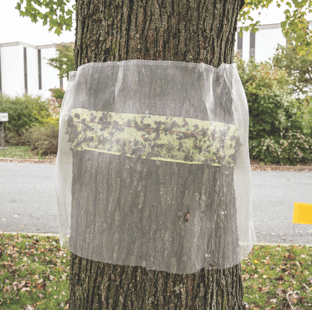
Lastly, you have the option of removing host trees. I don’t advise tree removal for the sake of removal, but removing Ailanthus does help reduce the population. Removing the tree and treating the stump to ensure it doesn’t grow back is the currently recommended practice.
Chemical Control
When you’ve exhausted cultural practices, it’s time for chemical control.
This guide to chemical control from Rainbow Ecoscience (2) is comprehensive. It includes the lifecycle of the pest, host plants, when to treat and which chemicals to use.
The short version is this: You must combine systemic pesticides in the trees you’re treating and foliar/trunk sprays. The foliar/trunk sprays control adult stages (and nymphs, depending on the timing of sprays). The systemic treatments (trunk spray or injection, depending on the tree’s location and the possibility of drift, contaminating drinking water, etc.) should be done in the summer to ensure enough time for proper uptake. Systemic products should be fully present throughout the tree by the time adults begin to emerge and certainly in time to reduce the mating population.
There is a danger with foliar/trunk sprays: impacting non-target organisms. Suppose the tree(s) you’re treating is close to an apiary. In that case, you should consider injection rather than trunk sprays for systemic products and skip the contact sprays to control adults altogether.
The same can be said for populations of other beneficial insects. Avoid sprays where the potential for drift impacts butterfly bushes and milkweed or where ladybeetle and praying mantis populations are high. These beneficials should be protected.
Biological Control Options?
Some biological control methods show promise in the fight against SLF.
Scientists are currently working with a natural predator, a parasitic wasp imported from Asia, to see if it will work to control the lanternfly population. Careful testing is needed to ensure it won’t begin to feed on native species before it is released into the wild.
Another control method with more publicly available research behind it is fungi. Two strains of fungus feed on the lanternflies well: Beauveria bassiana and Batkoa major. While little is known about B. major, B. bassiana has been used to control pest outbreaks in nurseries and greenhouses for years and is widely available online. However, most products containing B. bassiana are labeled exclusively for greenhouse or nursery use, not in a landscape.
Besides the labeling issues, there are unanswered questions regarding fungus as a control method. We have no idea how long a spotted lanternfly needs to be in contact with the fungus, whether they need to ingest it or only touch it, or how long either fungus takes to kill a lanternfly. If you need to know how long it will take to be effective (like on a college campus or commercial park, where you need results immediately for liability reasons), you’re better off with traditional, manufactured chemical control methods, responsibly applied.
Note: It is illegal to use a pesticide in a manner inconsistent with its label. Please read all labels for any products you intend to use and follow the label instructions for appropriate application methods, rates and target organisms.
Talking to Customers About Spotted Lanternfly
The communication with customers should be direct and fact-based. SLF will probably not kill the trees on their residential or commercial property. Will it weaken the tree and cause decline? That’s a possibility, but as yet unproven.
Can the black sooty mold that grows from the honeydew cause problems in understory plants? Yes. I’ve witnessed this firsthand when hostas were dying directly underneath some Tree of Heaven that were infested; the black sooty mold was completely hindering their ability to photosynthesize.
However, the real threat is more health- and safety-related; black sooty mold is a slipping hazard. I’ve seen it coat benches, sidewalks and stairs directly below where SLF is feeding in large numbers. It’s a potential liability for homeowners and commercial properties alike.
Secondary, but still a very real concern, is aesthetics. These bugs have no fear. They’ll land on anything and anyone. I was on a property with a television news crew, wrapping up a segment for a local station about SLF when one landed on the reporter. I’ve also brushed them off of people at neighboring tables when dining outdoors in areas where the pest is present.
Knowing this, the messaging becomes pretty straightforward. Are they a threat to the plant’s health in your average residential or commercial landscape? No. Are they nuisance pests that create the potential for actual harm to people and property? Absolutely.
Making Money From Spotted Lanternfly
This is pretty straightforward. You sell this as a recurring chemical service, like a traditional plant health care, lawn care or mosquito program.
If you live in a market where there are strict guidelines on pesticide usage or your consumers are particularly environmentally conscious, you can even sell the cultural practices (like banding and scraping) as a service. One thorough scraping in the winter and a few banding visits in the spring, added to the regular chemical treatments, will make you a lot of money.
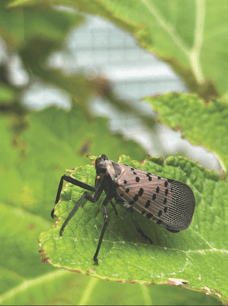
Conclusion
Hopefully, this gives you the insight you need to slow the spread of SLF. In just eight years, they’ve got from outside Philadelphia, Pennsylvania, to confirmed sightings west of Des Moines, Iowa.
While impressive for a bug that doesn’t truly fly, it’s a potential disaster for agriculture across the U.S. After reading this article, I hope you’re better informed and better resourced.
ADDITIONAL RESOURCES:
1 https://extension.psu.edu/how-to-build-a-new-style-spotted-lanternfly-circle-trap
2 https://www.rainbowecoscience.com/about-rainbow/news/spotted-lanternfly-mgmt-guide
Jay Worth
Marketing Manger for Single Ops
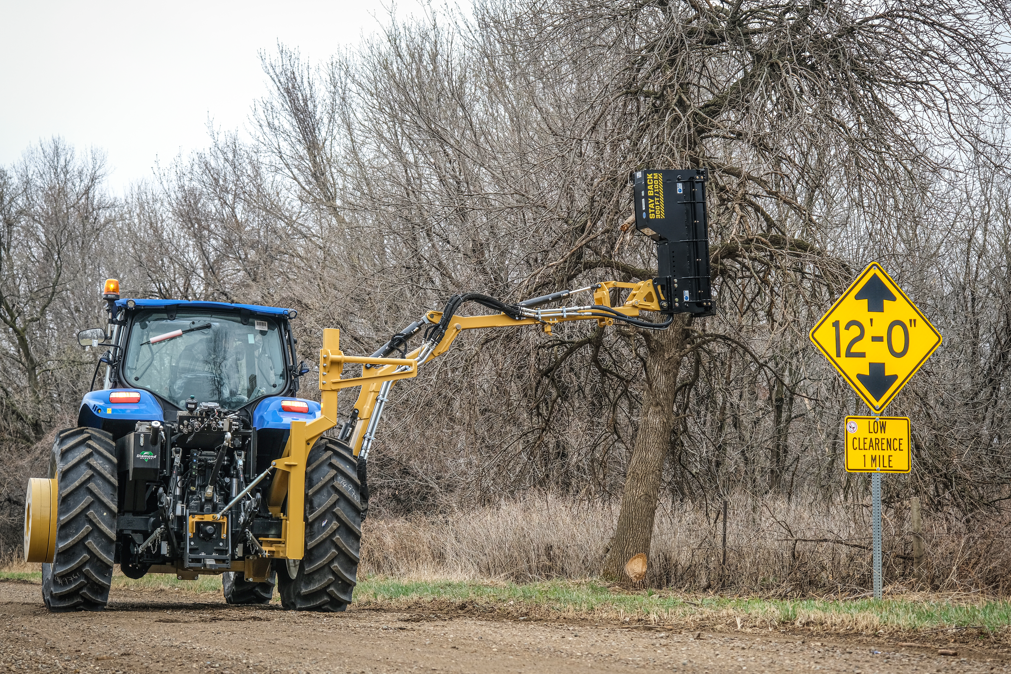
SIOUX FALLS, S.D., March 30, 2023 – Spring has sprung! With days getting longer and temperatures on the rise, it’s time for land-clearing...

Equip Exposition Debuts Certification Center to Help Landscapers Score Money-Making Credentials Turf Trainings Offered in Both English & Spanish,...